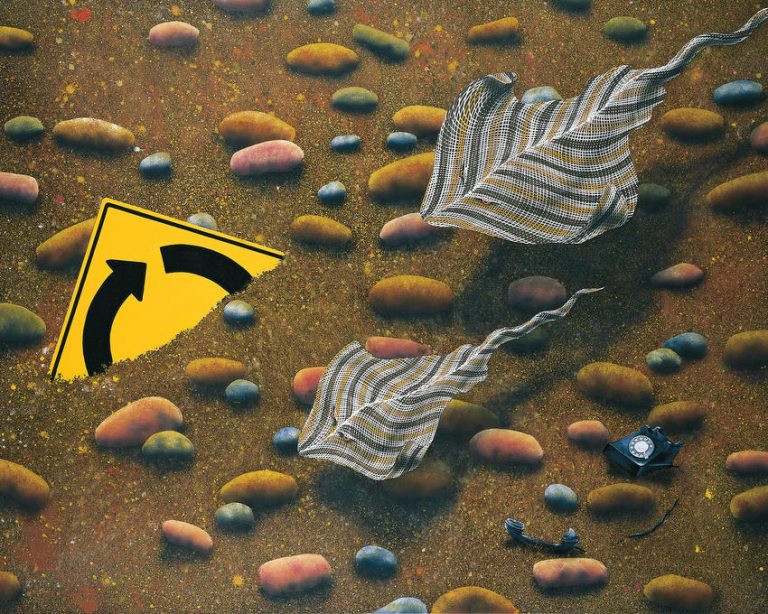We acknowledge the Traditional Owners of the land on which the Queensland Art Gallery | Gallery of Modern Art stands and recognise the creative contribution First Australians make to the art and culture of this country.

Lin Onus / Australia 1948–96 / Ginger and my third wife approach the roundabout 1994 / Synthetic polymer paint on Belgian linen / 200 x 250cm / Purchased 2000. The Queensland Government’s special Centenary Fund / Collection: Queensland Art Gallery | Gallery of Modern Art / © Lin Onus Estate/Licensed by Copyright Agency, 2016
Lin OnusGinger and my third wife approach the roundabout 1994
Not Currently on Display
Ginger and my third wife approach the roundabout 1994 seamlessly blends narrative, humour and collaboration, elements that have made Lin Onus a distinctive Australian artist.
The work, painted as a tribute to another well-known Indigenous artist, Ginger Riley Munduwalawala, astutely synchronises Indigenous and non-Indigenous elements. In 1994, Ginger Riley stayed with Onus for a few weeks to work with him in his studio. During his visit, he decided that Jo Onus (Lin’s second wife) was too busy to look after him.
Following a practice common amongst his people, Ginger Riley offered to find Onus a younger wife to help around the house, hence Onus’s tongue-in-cheek reference to his ‘third wife’ in the work’s title. Onus believed he had permission to use sacred rarrk as a result of interaction with artists from Gamerdi, near Maningrida. At the time of this work’s execution, he had been collaborating with Brisbane-based artist Michael Eather on a series of gouaches titled ‘The Ongoing Adventures of X and Ray’.
The series incorporates a stingray, ‘Ray’ (a metaphor for Michael Eather), and a dingo, ‘X’ (a metaphor for Lin Onus). Together these companions travel the known and unknown landscapes of Onus’s paintings, their journeys parallel with their own lives.
Lin Onus was born in Melbourne in 1948. His father Bill Onus was a Yorta Yorta man from the Aboriginal community of Cummeragunja in Victoria, near the town of Echuca, while his mother Mary McLintock Kelly was from a Scottish family in Glasgow.
As a child, Onus visited Cummeragunja with his father, and was told stories by his uncle Aaron Briggs, who gave Onus his Aboriginal name — Burrinja, meaning ‘star’. After leaving school at 13 he worked as a motor mechanic before joining his father’s business, Aboriginal Enterprises, making artefacts for the tourist market.
Appropriation, copyright and equality associated with the manufacture and trade of Aboriginal tourist items were critical issues that would later occupy Onus’s art and life. The discovery of a set of oil paints at his father’s workshop led Onus to painting small landscapes that he sold through the Sherbrooke Art Society Fair in 1974.
In 1975, Onus mounted his first exhibition at the Victorian Aborigines Advancement League in Melbourne. This organisation was symbolically significant for the young artist, foreshadowing the powerful link between his art and the political and cultural milieu that was to become a distinguishing characteristic of his career.
In 1986 Onus was introduced to the Gamerdi community at Maningrida in Arnhem Land and met traditional elders such as Jack Wunuwun (who became his adoptive father and mentor). Onus’s pilgrimages to the community allowed him to acquire knowledge about symbols, patterns, designs and stories, to develop a distinctive visual language.
In 1993 he was awarded the Order of Australia for service to the arts. Despite his premature death at the age of 47, Lin Onus has been widely acknowledged as a pioneer of the Aboriginal art movement in urban Australia.
Discussion Questions
If you were to represent yourself and your best friend as animals, birds or marine creatures, what creature would you choose and why?
Classroom Activities
Create a comic strip in which you and a friend embark on an adventure. Brainstorm ideas for adventures, creatures and characters.